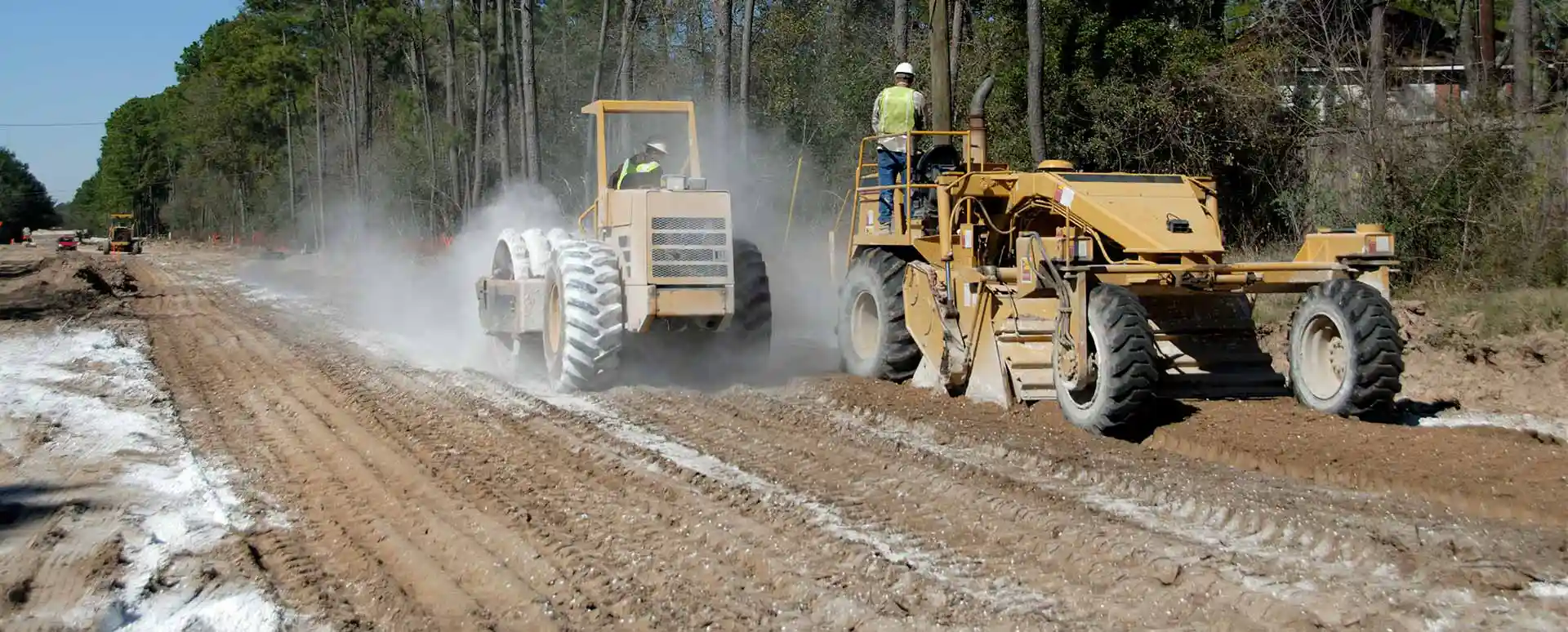Lime Soil Stabilization: Find the Best Soil Stabilization Method

Lime Soil Stabilization vs Cement Soil Stabilization: Which Method is Better? Many factors must be considered to choose the most effective stabilizing agent and properly stabilize soil.
What is Soil Stabilization?
Soil stabilization occurs when the physical and chemical properties of a soil are transformed to provide permanent strength gains by incorporating lime or cement. Soil stabilization builds on soil modification, enhancing the properties of soil. According to a 2017 LTRC study that evaluated lime usage in literature as well as construction/application techniques across the US, (lime) stabilized soils outperform non-stabilized soils when materials, design, and construction are properly considered. When the stabilized soil layer is incorporated into the structural design of the pavement, the subsequent layers can be reduced, resulting in sizable cost savings while minimizing the need for virgin material, among other benefits. In addition to adding strength, stabilized soils form a solid monolith that decreases permeability, which in turn reduces the shrink/swell potential of the treated soil and the harmful effects of freeze/thaw cycles.
Get back to work with less downtime.
Soil stabilization can improve in-situ, or natural state, soils, eliminating the need for expensive remove-and-replace operations. Often the native wet soils, where roads, building pads, parking lots, runways or other structures need to be built, are also weak soils. They can be chemically treated to add strength through soil stabilization and improve engineering properties, including moisture content and plasticity, through soil modification. Ex-situ, or off site, soil stabilization processes are possible but are usually reserved for environmental projects rather than typical construction operations. Pre-project testing looks at soil properties and can help determine how reactive the soil is. Testing is essential for soil stabilization to be certain that the right product is used for each project and that enough of the stabilizing agent is present to permanently stabilize the soil.
Lime Stabilization of Soil
Why is lime used in soil stabilization?
Lime treated soil can develop long-term, permanent strength in reactive soils resulting in soil stabilization. According to the National Lime Association, a soil with at least 25% passing a 75 micron screen (clay) and having a plasticity index (PI) of 10 or greater are generally good candidates for lime stabilization. However, testing has shown dramatic improvement in soils that didn’t meet that criteria so it’s important to not prematurely eliminate options without due diligence. Fine grained, moderate to high plasticity soils are almost always “prime for lime.”
Quicklime, hydrated lime and Calciment® LKD are proven options to properly stabilize soil, turning weak soils into more than a solid working platform.
Lime stabilization with quicklime and hydrated lime uses pozzolans, which are naturally present in clay soils, to generate cementitious bonds that permanently strengthen and stabilize clay soils. Calcium cations from lime react with pozzolans from the clay surface mineralogy, such as silica and alumina, and water to form calcium-silicate-hydrates (C-S-H) and calcium-aluminate-hydrates (C-A-H). C-S-H and C-A-H are the same products that are responsible for the strength in materials such as concrete.
Another lime product, Calciment® LKD, can supplement the pozzolans needed for lime stabilized soils. This product is very effective in more granular soils where there is not as much clay present.
What lime is used in soil stabilization?
The term lime can be used somewhat inconsistently. For soil stabilization purposes, the term lime must mean either quicklime, hydrated lime or Calciment® LKD. Chemically, quicklime is calcium oxide [CaO], hydrated lime is calcium hydroxide [Ca(OH)2] and Calciment® LKD is Mintek’s blend of reactive oxides and pozzolans.
When talking about different types of lime, it is worth noting that lime can be classified in two types, high calcium and dolomitic. High calcium quicklime is almost completely calcium oxide, whereas dolomitic quicklime contains a portion of magnesium oxide along with calcium oxide. While some industrial applications, such as steel, need the magnesium component for certain processes, for construction purposes high calcium and dolomitic are virtually indistinguishable. It is also worth noting that some inaccurately refer to agricultural lime, finely ground calcium carbonate [CaCO3], as lime. While ag lime can help farmers improve their soil by amending their fields, this other calcium-based product cannot be used for soil stabilization.
Hydrated lime is often referred to simply as “hydrate”. It is produced by further processing quicklime from calcium oxide to calcium hydroxide. This is done with specialized equipment that provides the necessary mixing while carefully adding the proper amount of water to quench the chemical hydration reaction, producing a very fine, high-purity product. Hydrated lime can still supply the calcium cations that are essential to stabilize fine grained soils. However, since the material has already been hydrated, it does minimize almost all of its drying capacity that is desired on wet job sites. Other considerations include limited availability as hydrators are only located in certain areas, additional costs for the added processing, and added handling concerns like dust generation and exposure.
Calciment® LKD is a co-product of the quicklime manufacturing process that is made up of finely sized particles. These particles are reactive calcium and magnesium oxides plus pozzolans from the fuel used to fire the lime kiln. Because it contains both calcium oxide and pozzolans, Calciment® LKD is a hybrid between quicklime and cement. As previously mentioned, lime works very well with fine-grained soils while coarser-grained low PI soils typically require cement. Calciment® LKD bridges the gap between cement conducive soils and quicklime conducive soils. Like cement, it flows well through spreader trucks and doesn’t require a mellow period.
Cement Stabilization of Soil
What is soil cement stabilization?
Soil cement stabilization is a construction technique used to increase the strength of subgrade soil by mixing it with cement and water. In this soil stabilization method, water hydrates cement, generating reactions that create a matrix between the soil particles which gives the soil strength. Cement stabilization is especially useful in low PI, coarse-grained soils. If cement is used to treat higher PI clay soils, an elevated dose would be required, making a project more costly than it would be if lime products were properly considered and utilized.
What is Portland cement?
Portland cement is the most common type of cement. Its basic components are sand and clay as well as calcium, silica, alumina, and iron derived from limestone. All are processed, fired in a kiln and pulverized to a fine powder. The final product is what we call Portland cement. When it is exposed to water, it chemically hydrates, resulting in a gel that forms an interlocking matrix around particles. It hardens as it cures, giving strength to the system.
Slight variations produce different types of cement. Changes in production lines, differences in raw materials and/or alterations at the end of the cement manufacturing process define the type of cement produced. Qualities like air entrainment, or millions of tiny air bubbles that resist stress due to freezing and thawing, are clearly distinguished. The American Society for Testing and Materials (ASTM) lists the different types of Portland cement in the following table. Type I and III are most commonly used in soil stabilization.
| Type | Description |
| I | Normal |
| I | Normal + Air Entrainment |
| IL | Normal + Extra Limestone |
| II | Moderate Sulfate Resistance |
| IIA | Moderate Sulfate Resistance + Air Entrainment |
| III | High Early Strength |
| III | High Early Strength + Air Entrainment |
| IV | Low Heat |
| V | High Sulfate Resistance |
Soil Stabilization Comparison Cost
Regardless of the specific stabilizing agent, there are many factors that affect the cost of soil stabilization including materials, delivery, application, and the availability of water. Material cost is regional, depending on local supply and demand. The costs associated with delivering material is dependent on the distance from the material production plant to the job site and trucking rates by location. While spreading with typical construction equipment, such as bulldozers and backhoes, is possible, an experienced contractor with specialized equipment like spreader trucks and soil reclaimers is recommended to properly spread and incorporate the material with the soil. Another facet of application is treatment depth, as more material is required whenever deeper treatment is desired. Treatment depths can range from 6 to 18 inches, but a 12-inch depth is typical. Finally, water accessibility also affects cost. Water is necessary to hydrate both lime and cement, pushing reactions to form strength generating bonds.
Regardless of all these factors, soil stabilization is almost always the most economical option, especially when compared to remove and replace operations. Soil stabilization improves the material that is already in place without the hazards and frustrating logistics associated with hauling material to and from the site. The cost of importing engineered fill materials and exporting sub-par materials is only increasing. Generally, chemically stabilizing soil can save about a third of the cost compared to removing and replacing wet, weak soil.
Soil stabilization saves time, money, materials, and energy.
We're here to help you find the best solution for your next project. Let's get started. Give me a call at 937-641-9901.

Josh Weser
Mintek Resources
Related Posts
Ground Control: Comparing Lime and Geosynthetics for Long-Lasting Stability
When building infrastructure on weak in-situ soils, a well-designed foundation is essential to ensure long-term resilience. Whether you're constructing roads, embankments, or industrial platforms, ensuring subgrade stability is critical—not just for performance, but...
Save Time and Money with Mintek’s Lime Stabilization Calculator
Lime stabilization turns challenging soils into durable foundations suitable for the construction industry. When lime-based reagents interact with soil, a chemical process alters its characteristics - binding clay particles, reducing plasticity & shrink-swell...
Exploring The Application of Lime Stabilization in Soil
Creating a stable foundation is essential for any construction project, yet many construction sites face challenges with unsuitable soil conditions. Lime soil stabilization offers a proven, cost-effective solution for transforming problematic soils into reliable...